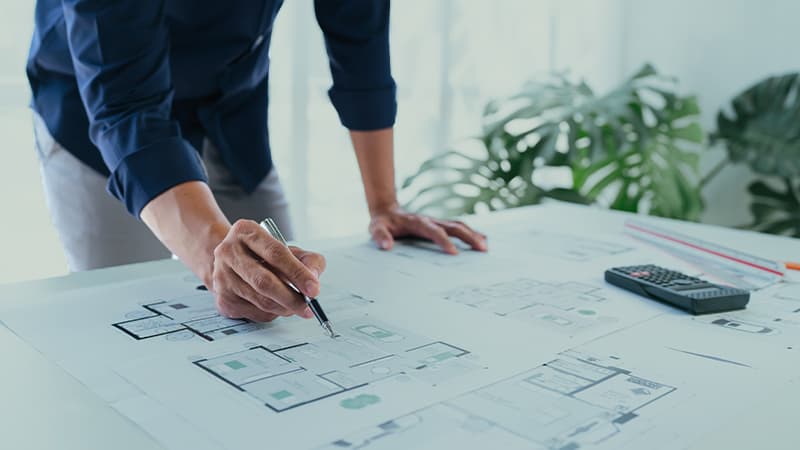Architect Insights on Balancing Form and Function
Architect Insights on Balancing Form and Function
Blog Article
Comprehending the Diverse Job Paths Available for Aspiring Architect
As an ambitious Architect, you have a world of profession paths waiting for you. Each course uses distinct obstacles and opportunities to use your imagination and technical expertise. Whether you're attracted to traditional architecture or the nuances of sustainable style, there's a specific niche that aligns with your passions. Comprehending these varied choices can shape your expert trip, however which instructions will you choose to discover initially?
Standard Style: Creating Frameworks and buildings
Standard design focuses on designing buildings and frameworks that blend performance with visual allure. As you discover this field, you'll appreciate the detailed equilibrium between kind and purpose. You'll discover to attract motivation from historic styles, integrating components like symmetry, products, and workmanship. Your designs can mirror social heritage, showcasing regional traditions while meeting modern needs.
You'll create skills in composing, model-making, and site analysis, allowing you to picture and interact your concepts properly. Involving with customers, you'll need to understand their vision and equate it into practical layouts.
Furthermore, developing codes and sustainability practices are vital in your job, guaranteeing your frameworks are risk-free and eco-friendly. As you grow in your job, you'll discover possibilities in domestic, industrial, and even reconstruction jobs, each offering special obstacles. Accepting standard architecture leads the way for a meeting career that pays tribute to the past while shaping the future.
Urban Preparation: Shaping Neighborhoods and Public Spaces
As an ambitious Architect, you can play a crucial duty as an urban organizer, transforming just how neighborhoods work and communicate. By using area engagement strategies, you'll guarantee that citizens have a voice fit their environment. Plus, incorporating lasting style principles will aid produce areas that not only satisfy today's requirements however likewise shield the future.
Duty of Urban Planners
While numerous could assume of architects as the sole visionaries behind structures, city coordinators play an important role in forming the wider landscape of neighborhoods and public rooms. They analyze land use, zoning legislations, and neighborhood requires to create lasting settings that enhance lifestyle. By teaming up with different stakeholders, you'll aid develop parks, transportation systems, and houses that advertise social interaction and accessibility. Urban planners also concentrate on environmental considerations, making sure that developments integrate eco-friendly rooms and support biodiversity. Your proficiency in spatial style and neighborhood characteristics permits you to visualize future growth while preserving cultural heritage. In this essential role, you'll directly influence exactly how individuals experience their environments, making every job an opportunity for favorable modification.
Community Engagement Techniques
Efficient community interaction techniques are crucial for metropolitan organizers to assure that the voices of residents are heard and valued in the planning process. To foster significant dialogue, you ought to prioritize open forums and workshops where neighborhood participants can reveal their ideas and issues. By proactively paying attention and incorporating feedback, you'll create areas that show the area's requirements, inevitably leading to more effective and lasting metropolitan settings.
Lasting Design Principles
When designing city spaces, incorporating sustainable style principles is critical for creating environments that thrive both environmentally and socially. You need to start by focusing on energy performance, utilizing products that lower waste and promote recycling. Take into consideration incorporating green areas, like yards and parks, to improve biodiversity and enhance air top quality. Promoting walkability and public transportation can minimize dependence on cars, cultivating a much healthier community.
Creating with water conservation in mind is also essential-- believe about rain gardens and absorptive surfaces to take care of stormwater. Involving neighborhood members during the planning process warranties that the rooms you create meet their demands and encourage social interaction. By welcoming these principles, you'll add to lively, sustainable metropolitan landscapes that benefit every person.

Landscape Design: Producing Lasting Outside Atmospheres
As you check out landscape style, you'll discover vital style principles that produce beautiful and functional outdoor spaces. Sustainable techniques play a crucial function in making sure these environments thrive while minimizing environmental influence. Plus, you'll locate a range of career possibilities that enable you to make a real distinction in exactly how people interact with nature.
Design Concepts in Landscape
Comprehending layout concepts in landscape architecture is crucial for developing lasting exterior environments that harmonize with nature. You'll need to consider aspects like scale, proportion, and balance to ensure your layouts feel natural and welcoming. Additionally, pay interest to seasonal adjustments, designing with products that match the surroundings year-round.
Sustainable Practices Summary
Lasting methods in landscape style not only concentrate on appearances however also focus on eco-friendly health and resource preservation. By integrating indigenous plants, you boost biodiversity and reduce the requirement for chemical plant foods and pesticides. Carrying out efficient irrigation systems aids conserve water and lessens runoff, shielding neighboring ecological communities. You can make areas that advertise soil health, such as using organic products and practicing permaculture principles. Additionally, including green framework, like rainfall gardens and porous pavements, aids in stormwater administration and reduces urban warmth. When you produce exterior atmospheres with sustainability in mind, you add to a much healthier planet and give areas that cultivate area link. Inevitably, these practices assure your styles profit both people and the atmosphere for years ahead.
Occupation Opportunities Expedition
With a strong structure in lasting techniques, landscape style provides a variety of career courses that enable you to make a purposeful effect on the atmosphere. Urban planners typically work together with landscape designers to create green areas in urban setups, improving city livability. If you're enthusiastic concerning education and learning, take into consideration ending up being a landscape architecture instructor, inspiring future generations.
Lasting Layout: Concentrating On Eco-Friendly Practices
As you discover your occupation in design, accepting green practices can set you apart in an affordable area. Lasting design concentrates on developing structures that lessen environmental influence while boosting owner well-being. By incorporating eco-friendly materials, energy-efficient systems, and lasting building methods, you'll contribute to a greener future.
Begin by gaining understanding of green accreditations like LEED or BREEAM, which can bolster your credentials. Take into consideration exactly how all-natural light, air flow, and thermal efficiency can enhance layout. Work together with designers and ecological consultants to innovate remedies that reduce waste and save sources.
Don't fail to remember the importance of neighborhood participation-- appealing neighborhood stakeholders can influence layouts that integrate with the environment. As customers progressively prioritize sustainability, your experience in eco-friendly techniques will not just bring in tasks but additionally fulfill your enthusiasm for liable architecture. Accept this critical element of the career, and see your career thrive.
Historical Preservation: Safeguarding and Restoring Social Heritage
While you begin on your building journey, think about the vital duty of historical preservation in keeping our cultural heritage. This area concentrates on the protection and restoration of considerable buildings, sites, and frameworks that inform the tales of our past. By taking part in historical preservation, you'll assist protect the architectural legacy that shapes area identification.
As a historical conservation Architect, you'll examine historic importance and evaluate the condition of structures. You'll work closely with historians and conservationists to assure genuine remediation methods are utilized. This profession path permits you to blend imagination with research study, allowing you to develop solutions that value original products and craftsmanship.
Your job not only adds to sustainability by recycling existing buildings yet likewise fosters a feeling of satisfaction within neighborhoods. Accepting this path will help you come to be a guardian of background, preserving the stories and visual appeals that improve our lives.
Interior Architecture: Enhancing Indoor Spaces
Historic conservation and indoor style both share a dedication to enhancing the built environment, however they concentrate on different facets. While historic preservation stresses maintaining a structure's historical and social worth, interior design absolutely nos in on enhancing interior areas for functionality and visual appeals.
As an aspiring Architect, you'll discover that interior architecture enables you to blend imagination with click here technological skills. You'll design spaces that not only look good but additionally advertise comfort and effectiveness. This field entails recognizing how light, shade, and products communicate within a room, influencing state of mind and functionality.
You'll service numerous jobs, from domestic homes to commercial workplaces, ensuring that each environment meets the needs of its occupants. By focusing on user experience, you can change interiors right into motivating and practical rooms, making a significant effect on how people communicate with their environments. Accept the possibility to boost interior settings and shape the method people live and work.
Industrial Layout: Combining Capability With Looks
Commercial design plays a crucial role in developing items that perfectly mix visual appeals with capability, ensuring that what you use everyday is not just visually attractive however likewise more info practical. As an aspiring Architect, you might engage on your own in this field, focusing on designing everything from furniture to customer electronic devices. Your job includes understanding customer requirements, materials, and making processes, permitting you to produce innovative remedies that improve daily experiences.
In industrial layout, you'll often team up with designers, manufacturers, and online marketers, making sure that your designs are not only beautiful however also possible. You'll find out to balance type and function, prioritizing use without compromising style. By sharpening your abilities in laying out, 3D modeling, and prototyping, you'll be fully equipped to bring your concepts to life. This job course supplies a vibrant setting where creativity meets functionality, making it a fulfilling choice for engineers curious about shaping the items of tomorrow.
Often Asked Inquiries
What Educational Accreditations Do I Required to End Up Being an Engineer?
To end up being a designer, you'll need a specialist degree in style, usually a Bachelor's or Master's. Additionally, you'll have to finish a teaching fellowship and pass the Architect Registration Assessment to practice legitimately.
Exist Certification Demands for Various Architectural Profession Paths?
Yes, there're accreditation needs for numerous architectural courses. Architect. You'll need to pass tests, total teaching fellowships, and sometimes pursue specialized training, depending on your picked focus, like landscape style, metropolitan design, or historic conservation
What Software Skills Are Vital for Engineers Today?

Exactly How Can I Gain Practical Experience While Researching Architecture?
You can gain functional experience by interning at building firms, getting involved in design competitors, volunteering for neighborhood projects, or teaming up with schoolmates on real-world projects. These opportunities boost your skills and build valuable links in the market.
What Task Opportunities Exist Outside Typical Design Firms?
You can explore numerous task opportunities outside typical design firms, like metropolitan planning, interior decoration, landscape style, construction monitoring, realty advancement, and even roles in sustainability consulting. Each offers special challenges and rewards.
Whether get more info you're drawn to traditional style or the nuances of sustainable layout, there's a particular niche that aligns with your rate of interests.When creating city spaces, integrating lasting style concepts is critical for producing environments that grow both ecologically and socially.As you discover landscape design, you'll discover essential layout principles that develop practical and gorgeous outdoor spaces.Recognizing style principles in landscape architecture is essential for creating lasting outside environments that harmonize with nature.In commercial style, you'll frequently team up with suppliers, marketing professionals, and designers, making sure that your styles are not only gorgeous however also possible.
Report this page